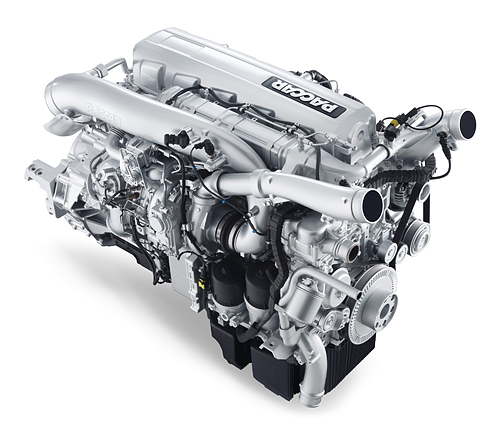Exciting trucking industry news recently released by DAF Trucks NV appears destined to have a decidedly positive impact on the industry worldwide. This is an example of government regulation actually helping rather than hurting trucking companies, owners and operators in their quest to become more efficient and profitable in their operations.
DAF, headquartered in Eindhoven, Holland, a subsidiary of American truck manufacturing giant PACCAR, is now in production of their new-generation MX-13 Euro 6 engines for heavy trucks. Designed to comply with new European Union emissions laws set to take effect in January 2014, the 12.9-liter, six-cylinder MX-13 engine incorporates a combination of tried and true Euro 5-compliant engine technologies plus implementation of a large number of technological innovations. The result is a power plant that is more fuel efficient, quieter, more powerful and that requires less maintenance than either its predecessor or anything else available in the marketplace.

Innovation Produces Leaner and Meaner Operation
Currently in the U.S., about 25 percent of Kenworth and Peterbilt trucks sold since the middle of 2010 have been equipped with the PACCAR MX engine designed to meet EPA 10 emissions specifications, which are nearly as strict as those soon to be implemented in Europe. Systems such as exhaust gas recirculation, an active soot filter and a variable-geometry turbo charger have helped in achieving emission standard compliance. Other features that make the MX engine a standout and one of the best in the industry include:
- A newly designed, smaller, lighter weight engine block made of graphite iron that’s stiffer and more durable
- 13-liter, 485-horsepower, 1,650-ft/lbs of torque that acts and feels like a bigger, 15-liter engine
- SRC, selective catalytic reduction, almost totally eliminates smog-producing nitrogen oxide while simultaneously boosting fuel economy
- The exhaust manifold is encapsulated to enhance turbocharger efficiency
- The crankshaft is precisely engineered, alleviating need for counterweights
- Many functions have been integrated, such as a “common rail” injection system that’s driven by the same camshaft as the valves
- “Smart dosing” of injected fuel (at pressures up to 2,500 bar) compresses only the amount of fuel/air needed, minimizing hydraulic loss and emissions output and maximizing fuel efficiency
At Domenico Transportation, we have logged close to a million miles on our MX’s combined and have no issues with performance. Downtime has been minimal, primarily for ECM updates to the engine software. These engines have the best fuel economy within my fleet, and can keep up with the 15 Liter engines pulling 6-8% grades. The emission components perform better than expected with approximately 2% DEF usage, and very few Regens. The MX has become the new standard in the trucking industry.
